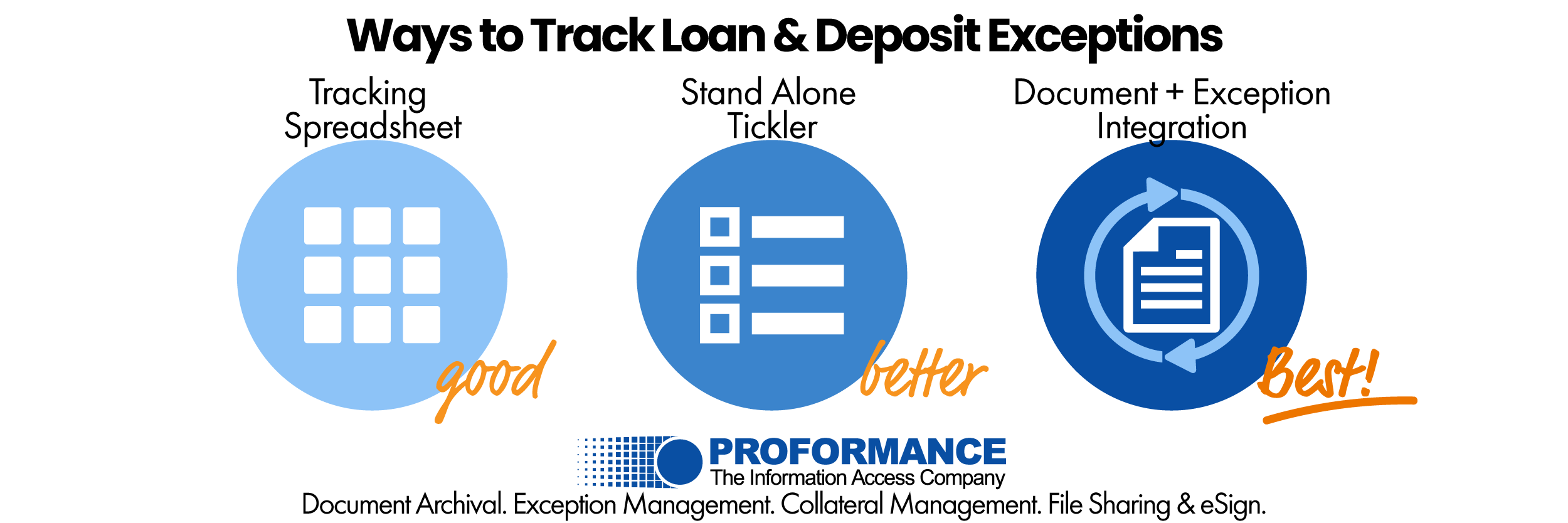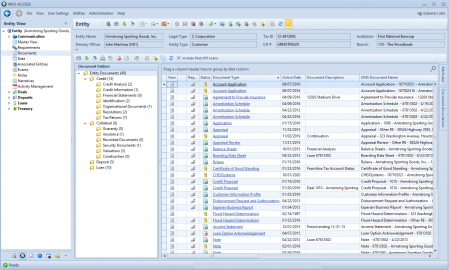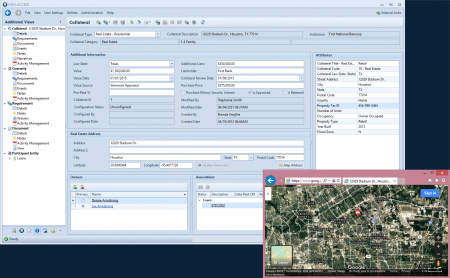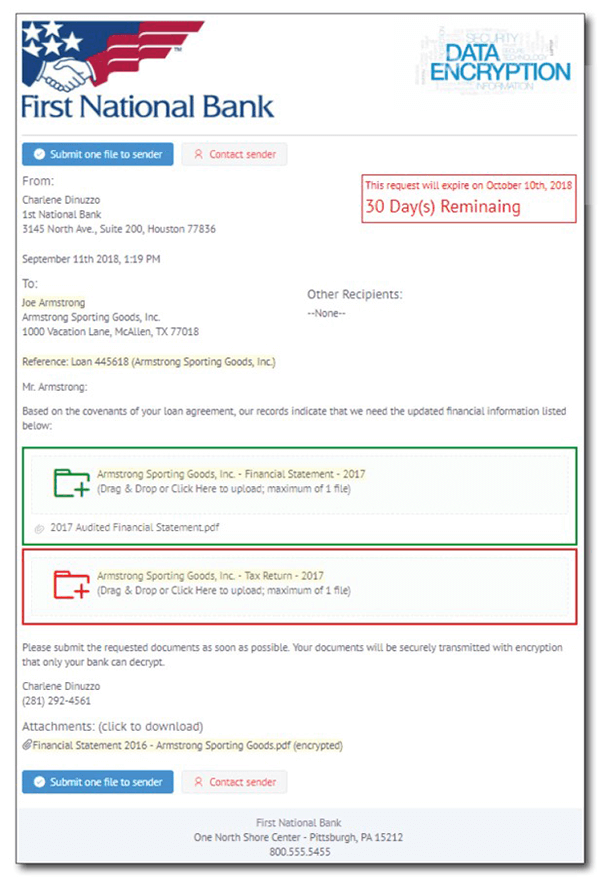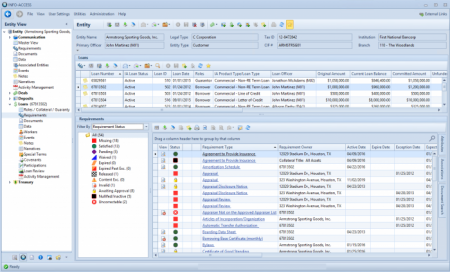EXCEPTION TRACKING
Exception Management Best Practices for Banks & Credit Unions
Overview of Exception Tracking
What is exception tracking and why is it important to banks and credit unions? What's are the pros and cons of a tickler tracker vs exception management enterprise software? Read on to learn the best practices of exception management.
What Are Exceptions?
For banks and credit unions, exceptions occur anytime documentation or criteria for a loan or a deposit account does not meet the institution’s established policy. Both lenders and deposit account officers are expected to follow their bank or credit union’s policies for approving loans and choosing to open deposit accounts. The policies are meant to keep new loans and accounts within the financial institution’s risk appetite.
Types Of Exceptions
There are two primary types of exceptions: document exceptions and policy exceptions
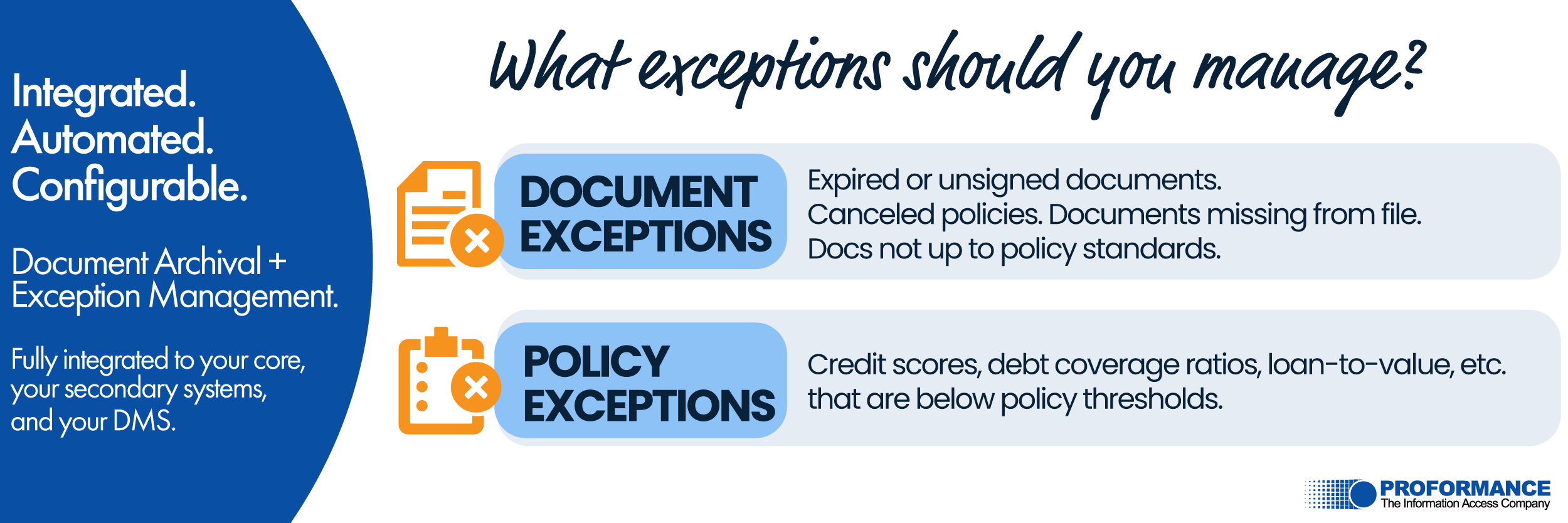
Document Exceptions
Document exceptions occur when a document provided by a customer for the purposes of obtaining or maintaining a loan or opening a deposit account do not meet the criteria set by the institution’s policy. A document exception may occur when a required document is expired or unsigned or does not contain the necessary information that is required.
A common example would be a missing signature on a tax return or financial statement. Many institutions require some form of signature on tax returns and financial statements in order to make them valid in a court of law, but it’s very common for lenders to receive unsigned documents of this nature during the loan underwriting process as customers are quickly sending requested information.
Policy Exceptions
Policy exceptions occur when data, not document content, fails to meet the institution’s policy. An example of a policy exception is when an applicant’s credit score is below the policy threshold to qualify for a loan or when the calculated debt service coverage ratio is below the policy threshold. In these examples, the exception is related to a determination and not related to a specific document.
Should I Eliminate All Exceptions?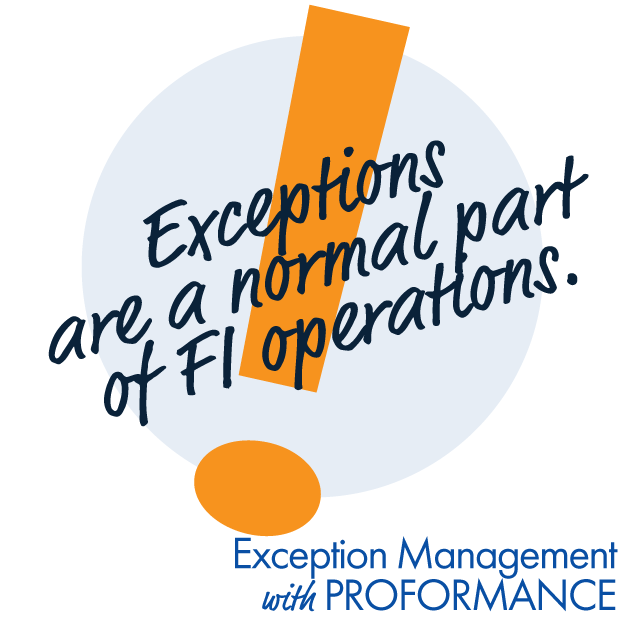
Absolutely not. Exceptions are a normal part of operations, and the existence of an exception or two does not prevent the bank or credit union from extending credit or opening an account. Each institution evaluates the creditworthiness of a loan based on many factors including, but certainly not limited to, adherence to policy. Where exceptions to policy occur so likely are mitigating risk factors that would cause a financial institution to approve the loan or open the deposit account even with exceptions. It is the job of management and their teams to weigh the risk versus reward of each opportunity.
From there, each institution will establish methods for reporting and managing aggregate risk. Because of this, quality exception tracking and management are essential, but before we dive into how and why to tracking exceptions let’s also review when exceptions occur.
When do Exceptions Occur?
Exceptions can occur during the loan underwriting or account opening phase or they can occur after a loan has been originated, and less frequently, after a deposit account has been opened.
Exceptions During Origination
Exceptions that occur during the process of underwriting and booking a new loan or opening a new deposit account can be wide-ranging. Problems may exist where specific documents are missing appropriate signatures or dates or where required documentation is overlooked and was not returned to the bank or credit union at all. The financial institution establishes quality review departments to limit these occurrences because failing to obtain signatures, dates, or specific documents can result in the risk of loss to the institution.
For this reason, most institutions establish both pre and post documentation reviews for new loans. These reviews allow experienced staff to review a loan package for accuracy and completeness both before the loan package is turned over to closing and after the package is returned. During these steps, exceptions to documents and policy can be recorded and tracked allowing the lender to cure outstanding exceptions and the institution to limit and manage risk.
Ongoing Exceptions
Banks and credit unions perform ongoing risk management tasks for their largest loans, loans within a concentration, or loans that meet other specific criteria set out by their loan policy. For example, most institutions will track for recurring financials and tax returns on their largest loans for the purpose of performing annual credit reviews.
Example: Financial Exceptions
On the largest loans, the borrowers and guarantors agree to provide updated financials on a set schedule as part of the terms of their loan agreement, and the institution uses these to assess that the borrower continues to show the ability and capacity to repay their debt. A decline in their ability to perform as expected on the loan can indicate the borrower and guarantors may default, leaving the institution to foreclose on property or even write-off losses. To perform ongoing risk analysis, the institution must track and request update financials as determined by their policy schedule and the loan agreement made with the borrower.
Example: Insurance Exceptions
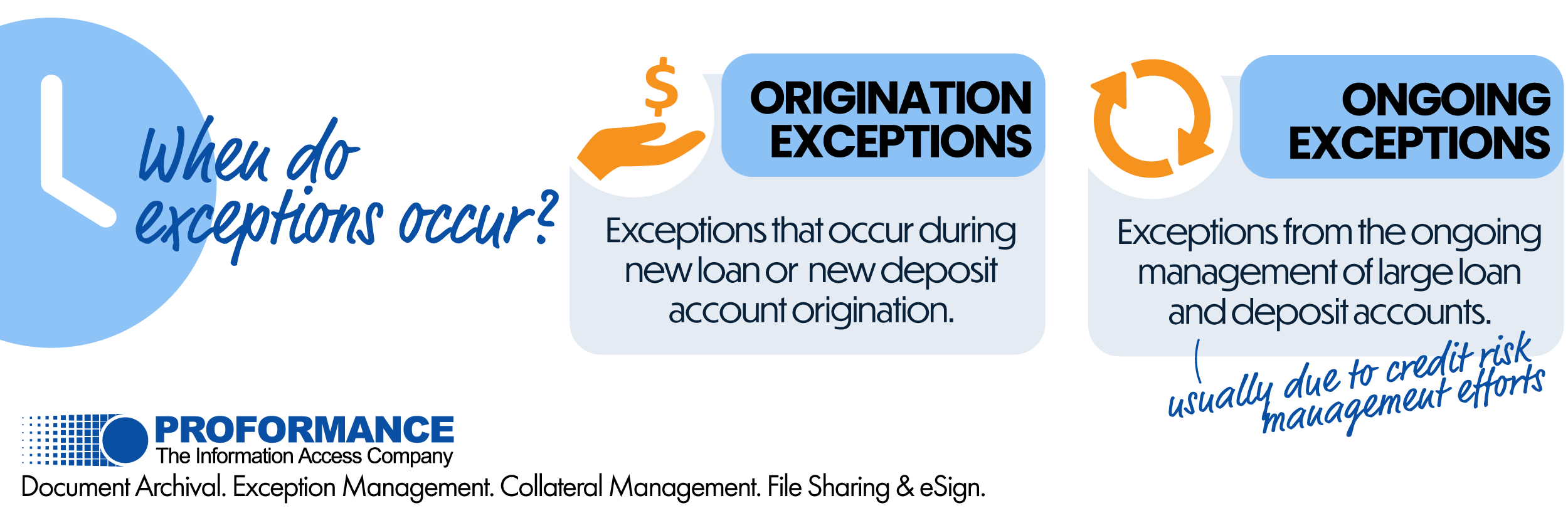 Expiring insurance is another common ongoing document exception that many institutions must track and cure. For loans secured by collateral, the loan agreement will nearly always require that the borrower maintain property insurance (and possibly flood and other types of insurance) in force for the life of the loans. Unless they outsource this tracking to a third-party, it falls on the bank or credit union to know when insurance policies expire or are canceled and to obtain proof that a new policy in force.
Expiring insurance is another common ongoing document exception that many institutions must track and cure. For loans secured by collateral, the loan agreement will nearly always require that the borrower maintain property insurance (and possibly flood and other types of insurance) in force for the life of the loans. Unless they outsource this tracking to a third-party, it falls on the bank or credit union to know when insurance policies expire or are canceled and to obtain proof that a new policy in force.
Exception Tracking
What is Exception Tracking?
Exception tracking is the activity of tracking document and policy exceptions whether they occur during the loan origination or account opening process or whether they occur on an ongoing basis after a loan or account has been established. As you can see, exception tracking is a key component of effective risk management for banks and credit unions.
Types of Exception Management | What’s the Best Way to Track Exceptions?
Let’s start by reviewing the most common ways to track for exceptions.
Tracking Exceptions by Spreadsheet
It’s surprising how many institutions still run their exception tracking by spreadsheet. While the cost to use is negligible and the time to get started is very quick, the complexities of exception tracking quickly outgrow spreadsheets. This method certainly does not support the needs of a large, growing, or complex institution. What’s worse is they hamper productivity and the risk for inaccuracies is large.
With spreadsheets, your institution is relying on personnel to review incoming documents and information that is archived in either paper files or a siloed document management system (DMS). The likelihood that documents enter the DMS and miss the team that manages the exception tracking spreadsheet is high, and this results in mismatched record keeping. Loan exception tracking using spreadsheets also opens the door for user error or even accidental file corruption.
Even very conscientious staff who limit these problems still spend a significant amount of time managing and maintaining the spreadsheet and then manually producing lender and management reports on a weekly, monthly, quarterly and annual basis. There is so much manual labor involved in managing exceptions via spreadsheet that it’s well worth the time to explore more productive solutions.
Tickler Tracking System
Some institutions have upgraded slightly from exception tracking spreadsheets and instead use a tickler tracking system. Tickler Trackers are essentially stand-alone software with more sophistication than a spreadsheet.
A bank or credit union adds a record, or reminder, to the tickler tracker about when a document expires or when something new is needed in file. At the specified date and time, the tickler system returns the reminder to the queue to be resolved. Tickler tracking systems have less risk for data loss or corruption and allow for basic tickler reports to be produced.
Tickler systems still do not solve the problems of working in siloed systems; therefore, the risk of incoming documents bypassing the team that mans the tickler system is still likely. This means that the document management system and the tickler tracking system can very often be out of sync.
With either of the above tracking options, it is nearly certain that employees will still find themselves running down documents that came in and missed the tickler tracking team to update ticklers after the fact. All too often, this can lead to frustrations between loan operations and lending staff and branch teams, and deposit operations because inaccurate exception reporting can give the impression that the lending staff isn’t maintaining their portfolios properly and it can even impact their incentive pay.
Integrated Document Management and Exception Management Systems | Exception Management Enterprise Software
The best option for accurate and efficient exception tracking is with a system that integrates document archival and exception tracking. By connecting document imaging to exception tracking, exceptions are cleared as documents are archived to the document management system (DMS).
How does this work? Document data, like the active and expire dates, that have to be collected for your document management system (DMS) anyway is the same critical information that drives exception tracking. With a system that serves as your document archival or with one that connects to and fully integrates with your document archival, the document data can be leveraged to drive exception tracking whether the tracked requirement is for a one time document, like a missing recorded deed of trust, or whether the tracked required is for an ongoing tracked document, like annual financial statements
- For one-time, or trailing documents, like the recorded deed of trust, the addition of the document to the DMS can satisfy the tracked item, provided the document meets the designated rules for the bank or credit union.
- For ongoing tracked items, like financial statements, document expiration dates signal these systems to begin tracking for an updated
The integration of document tracking and exception tracking means that the institution is no longer relying on personnel to keep two siloed systems in sync manually. Any user that adds a document to the DMS is, with or without knowing it, helping to maintain exception tracking. Let’s take a look at the benefits of an integrated solution in the next sections.
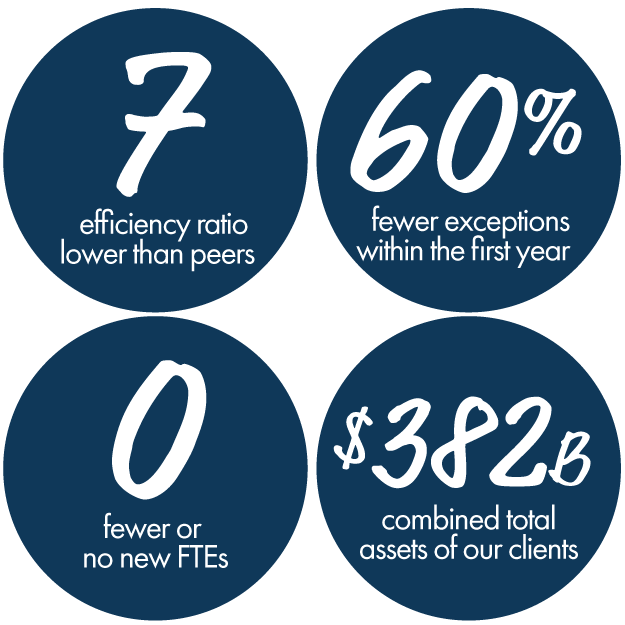 Do Exception Management Systems Actually Have an Impact?
Do Exception Management Systems Actually Have an Impact?
- Efficiency ratios after the first year are more than 7 points lower than their peer groups.
- Loan exception and deposit exception levels (tracked ticklers) decline by more than 60% within the first year.
- Our clients report more efficient workflow processes without the need to add additional staff or by operating with fewer FTEs.
What Functionality Does Exception Tracking Software Provide?
One example where our clients benefit from a system that integrates document management and exception tracking is by improving the workflow of clearing an exception as shown below:
- An employee (lender, loan assistant, deposit officer, CSR, or loan or deposit operations staff) can upload a document to INFO-ACCESS. That document is automatically archived to your document management system – whether that DMS is through PROFORMANCE, Synergy by Jack Henry and Associates, OnBase by Hyland, or another.
- If a tracked requirement or exception exists for the loan, deposit, or customer, the system matches the new document to the tracked tickler item and automatically satisfies the exception. Since exceptions are marked with easy-to-use, color-coded icons and the system works instantly, your team can watch their red missing exceptions to turn green satisfied requirements in real-time.
- After that, the loan or deposit account officer’s personal interactive exception work queue updates, and the exception is automatically removed from management reports.
All of these things happen at the same time, without your team updating a siloed spreadsheet or working in multiple systems.
Reporting and Managing Exceptions
The goal of loan or deposit exception management isn’t only to review, track, and cure exceptions. The quality and accuracy of exception report is a critical management tool for your bank or credit union. And, your regulator agrees. The ability to properly track, work, report, and manage exceptions is a core part of your annual exam, and the way in which exceptions are managed across the institution speaks directly to the effectiveness of your management team.
Strategies for Managing Exceptions
Exception reporting shouldn’t merely be a report that is tucked away in the quarterly board package to satisfy an examiner requirement. Examiners intend for management teams and risk officers to use the aggregate reporting to properly manage the current operations and analyze overall risk appetite to make adjustments when necessary.
For example, managers should analyze trends in both policy and document exceptions. Are exceptions levels for a particular requirement always or consistently above your loan or deposit policy? If so, it’s the job of the management team or risk officer to determine the cause. Perhaps your institution’s risk appetite has changed resulting in the need to update a policy that will eliminate repetitive exceptions. If the risk appetite hasn’t changed, then the institution needs to determine and address the cause of consistently violating its own policy.
Exception Reporting Tools
Keep in mind the following reporting tips to aid in your analysis:
- Tools that categorize exceptions into risk tiers, like critical vs. non-critical exceptions, can be used to stratify analysis and reporting. It may be better to report only critical exceptions to the board and senior leadership. This ensures that your most senior officers and leaders are focused on the most critical exceptions. Consider classifying exceptions that could lead to loss – like imperfect loan or deed documents, missing insurance, and the like – as critical exceptions rising to the level that senior management should give special attention.
- Customize reporting to fit your audience. For example, reports for deposit account officers or lenders could be grouped by borrower or account holder. This will allow the officer to easily review all issues with their customers when making a business call.
- Account officer and lender reports may also require a deeper level of detail than management reports. Review your reports to ensure they are informative and well-organized. Each employee is being pressed to be more productive and more efficient. Giving them quality and timeline information will make it easier for all teams to work together.

See INFO-ACCESS in ACTION now.
Request your on-demand video
overview now.
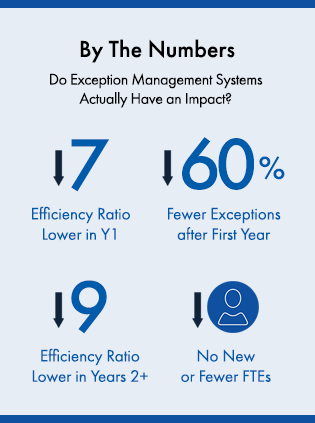

See INFO-ACCESS in ACTION now.
Request your on-demand video
overview now.
The Bottom Line
Exception Management is a critical task across your bank or credit union. Whether your institution has quantified this activity or not, bank and credit union employees spend a considerable amount of work hours on identifying, mitigating, tracking, reporting, and correcting exceptions on loans and deposits. All too often, financial institutions fail to make a conscious decision on how to effectively and efficiently track and manage exceptions. This leads to disparate, time-consuming processes. Be sure to take an intentional assessment of your institution’s exception management for both loan exception tracking and deposit exception tracking. Consider solutions that integrate documents with exception tracking to automate many processes related to this core responsibility.

